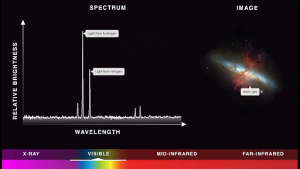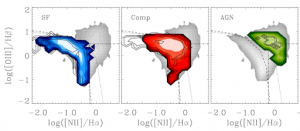
Multi-wavelength emission lines are prominent features in observed galaxy spectra, emerging from different gas elements in the galactic interstellar medium due to various ionisation, excitation and de-excitation processes of atoms and ions in the gas. Such spectral features are of high relevance for astrophysicists, as they have been classically used to derive different gas and radiation properties from observed galaxy spectra. Specifically, optical and UV emission lines, which originate from ionised gaseous regions in galaxies, enable, for example, a distinction between star-forming and active galaxies, or an estimation of the fraction of elements heavier than Hydrogen and Helium in the gas content of galaxies.
Since more than one decade, primarily at low redshifts, spectra with multi-wavelength emission lines have been routinely observed for large galaxy populations (e.g., the Sloan Digital Sky Survey). But only thanks to the recent advent of revolutionary observational, spectroscopic facilities, such as ALMA and JWST/NIRSpec, large samples of high-quality spectra can be collected also for high-redshift galaxies out to cosmic dawn. However, at such early cosmic epochs, a robust interpretative framework of emission lines is still largely lacking because of rather extreme galactic environments and conditions compared to that in the low-redshift Universe.
Thus, at GALSPEC, we aim to provide an accurate theoretical framework for the interpretation of emission lines of galaxies near and far, by modelling synthetic spectra with emission lines for simulated galaxies over cosmic time. This enables us to explore and identify new optical and UV emission-line diagnostics, which, when combined with observations, will allow us to put robust constraints on still uncertain models for early galaxy and black hole growth, and thus, to answer fundamental questions about the emergence of our Universe.
